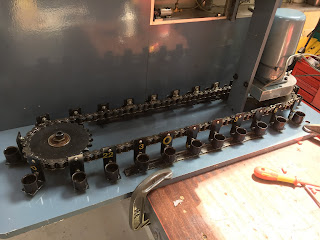Now that it's in the workshop, it's time to get it onto the bench and take a closer look. First, clamp it to a trolley so it doesn't fall off - it's a bit top heavy:
There's a convenient feature for lifting:
Up onto the bench:
Take a closer look. These are the solenoids:
This cable wasn't connected to anything. It used to go to that air pressure microswitch at the left:
Each of the main subassemblies has its own connector. So the main board can be disconnected fairly easily.
Electrical stuff:
Here it is. The wires solder to the bottom of the board and all the connectors are inline. The harnesses are old school, with waxed lacing. Haven't seen that for a few years.....
Here's the main (ie relay and diode) board with the 12V regulator and 555 timer at the top:
Underside. It's been laid out by hand with Letraset tape and Dalo pens. The idents are hand written in the copper. It will take a bit of deciphering....
So, may as well take a few pics for the record....
This funny board has a classical C230B thyristor (25A 200V) and a couple of pots and resistors. I assume it's a timer for the power drawbar. All handmade, with no actual copper tracks.
The Geneva mechanism has just the motor and what looks like a position switch:
The front box has loads of switches and includes the optional up/down speed controller. Not relevant to my machine which has a fixed pulley and factory VFD.
Here's the underside of the spindle speed "up down" controller:
Cleans up nicely with WD40, tissue and elbow grease:
Similarly the rest of the gubbins:
With the front switch box removed, it all cleaned up nicely.
How does it work?
Having cleaned it up a bit, next I need to figure out what the bits do. I assume the multicore cable is a 24VDC input jobby that directly drives the relevant relays. There seemed to be a pair of (24VDC and 110VAC) supply cables, so perhaps I can start by tracing them and the multicore cable back...
Yes, sure enough, the 24VDC come in on the terminal block at the front, goes through a fuse, then the manual / auto switch and then onto the main board. There's an LED for each mode. And the 110VAC also comes in on the same terminal block, through a fuse and the same manual / auto switch (different contacts obviously) and over to the main board.
The LM340K-12 regulator (in a TO-3 can) is massive overkill. It simply powers the 555 timer, which drives a 2N3904 (NPN) signal transistor (through a 6k8 resistor) which in turn drives a 24V relay. It's clearly just a delay timer to allow the power drawbar (PDB) to engage before the motor spins. I won't be using it anyway.
So the board has a mixture of 110VAC and 24VDC (and a little bit of 12VDC). I'm pretty sure the 110VAC needs to be isolated, as it seems to be grounded and even if it isn't, the creepages and clearances for US equipment back in the
70s probably lacks a little of the safety margins we'd expect today.
It also looks as if the Geneva mechanism motor is 110VAC, as suspected, although this should become clear when I power it up.
The forest of diodes are all the same type - 2A / 200V glass passivated avalanche diodes 1N5059. Never heard of them but they seem to do the job of flywheel diode (for the relays) and ORing diodes for the "logic".
Don't see any obvious reason not to power it up, although I should try to figure out the various inputs on the multicore signal cable first, as it will be tricky once the main board is back in place. It should all work in manual mode of course but the final outcome would be something that works in auto mode is using remote inputs via that signal cable.
How to control it?
I have a couple of Arduino Mega 2560s which would be capable of handling loads of IO but if I were to gut the whole thing and completely replace the logic with an Arduino, it would require a massive amount of reverse engineering. If I can get the thing to behave in "auto" mode, I may be able to write something in "PLC" code for the Centroid Acorn to do the control logic.
I could just about make do with providing inputs like "index forward", "index reverse", "tool in", "tool out" etc and outputs such as "indexing finished", "tool home position" etc. Having said that, I think I may struggle to find enough free IO on the Acorn.....
Did some wire tracing and comparison with the schematics which confirms that said schematics are quite different - names, colours, pin numbers - they describe a significantly different product. However, the basic functions are unlikely to have changed. Here are a few notes for (my) records.
And FWIW, here's a barely legible label that I suspect identifies the connections to the VFD UP / DOWN board:
I can just about make out words like "RPM", "TURRET", "DIRECTION"
- RPM GREEN
- RPM WHITE
- RPM BLACK
- __ET RED
- __ET BLACK
- REVERSE BLACK(???)
- ___ GREEN
- CHANGE MOT(???)
Typewritten paper labels and 40 years of oil haven't helped to make it legible...
Next steps:
I'll reassemble the main board into the machine and prepare to power it up. That will have to wait until next weekend when I return from working away during the week.
I need to get into programming Centroid Acorn "PLC" code. God knows why they called it that, as it's neither a PLC nor any similar form of language from what I know. From my previous experiences with the Acorn, this is likely to be a not insignificant challenge, not least due to the patchy documentation.....









































No comments:
Post a Comment